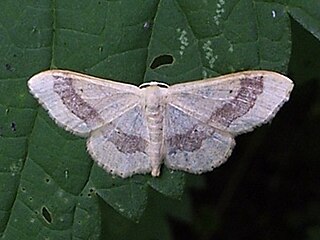
The riband wave is a moth of the family Geometridae. The species was first described by Carl Linnaeus in his 1758 10th edition of Systema Naturae.

The common pug(Eupithecia vulgata) is a moth of the family Geometridae. It is a common species across the Palearctic region, including the Near East and North Africa. It ranges from the Atlantic coast of Ireland and Portugal across Europe, the Middle East and Central Asia to the Russian Far East (Priamurje) and Korea.

Scopula imitaria, the small blood-vein, is a moth of the family Geometridae. It was first described by Jacob Hübner in 1799 and it is found throughout Europe and in North Africa.

Scopula immorata, the Lewes wave, is a moth of the family Geometridae. It is found throughout Europe and the Near East.

Scopula immutata, the lesser cream wave, is a moth of the family Geometridae. It was described by Carl Linnaeus in his 1758 10th edition of Systema Naturae. It is found throughout Europe.

Scopula marginepunctata, the mullein wave, is a moth of the family Geometridae. It was described by Johann August Ephraim Goeze in 1781. It is found throughout Europe.

Ennomos fuscantaria, the dusky thorn, is a moth of the family Geometridae. The species can be found in the western part of the Palearctic realm in western Europe and from central Scandinavia its range extends to the northern Mediterranean and east to Russia.
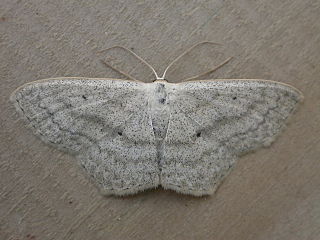
Scopula nigropunctata, the sub-angled wave, is a moth of the family Geometridae. It is found through most of the Palearctic realm.

Scopula rubiginata, the tawny wave, is a moth of the family Geometridae. The species was first described by Johann Siegfried Hufnagel in 1767.

Scopula ternata, the smoky wave, is a moth of the family Geometridae. It was described by Franz von Paula Schrank in 1802. It is mainly found in northern and parts of central Europe and in isolated populations in southern and south-eastern Europe. Its western range is eastern France, eastern Belgium and Scotland, with an isolated population in the Pyrenees. In the north its range extends to the polar regions and in the south it is found up to the Alps. Its eastern range extends through central and northern Russia up to the Ural, through Siberia up to the Yenisei River.

Sterrhinae is a large subfamily of geometer moths with some 3,000 described species, with more than half belonging to the taxonomically difficult, very diverse genera, Idaea and Scopula. This subfamily was described by Edward Meyrick in 1892. They are the most diverse in the tropics with the number of species decreasing with increasing latitude and elevation.

Scopula limboundata, the large lace-border, is a moth of the family Geometridae. It was described by Adrian Hardy Haworth in 1809. It is found in North America east of the Rocky Mountains. There is a single and unconfirmed record from Great Britain.

Scopula emutaria, the rosy wave, is a species of moth in the family Geometridae. It is found in western and south-western Europe and Romania. Also in North Africa.

Scopula subpunctaria is a species of moth in the family Geometridae. It is found from northern and north-eastern China to the southern Palearctic realm.

Scopula corrivalaria is a moth of the family Geometridae. It is found from Japan, Korea, China and the Russian Far East through Siberia and Russia to western Europe. In Europe, it ranges from northern Central Europe to the Mediterranean. The habitat consists of marshes and wet meadows.
Scopula emissaria is a moth of the family Geometridae. It was described by Francis Walker in 1861. It is found in India, Sri Lanka, Myanmar, Vietnam, China, Korea, Japan, the Philippines, Sumatra, Java, Wallacea and Australia.

Scopula fibulata is a moth of the family Geometridae first described by Achille Guenée in 1858. It is found in Kenya, Sri Lanka and China.
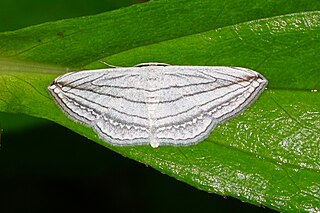
Scopula opicata is a moth of the family Geometridae first described by Johan Christian Fabricius in 1798. It is found in tropical Africa, including Malawi and Zambia, as well as in Sri Lanka, India, China (Hainan), Myanmar, Sundaland, the Philippines, Sulawesi, Timor and New Guinea.
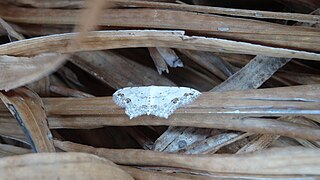
Scopula pulchellata is a moth of the family Geometridae. It is found in the Indo-Australian tropics, from India, Sri Lanka to Taiwan and the Solomon Islands, as well as in Africa.
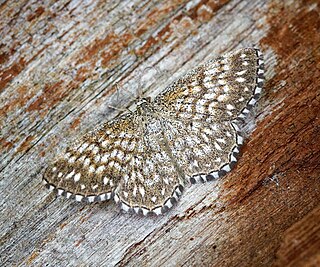
Scopula tessellaria, the dusky-brown wave, is a moth of the family Geometridae. It is found in Belgium, Luxembourg, France, Germany, Italy, Spain, Albania, former Yugoslavia, Croatia, Bulgaria, Romania, North Macedonia, Greece, Moldova, Ukraine and Russia. In the east, the range extends to the Near East and the eastern part of the Palaearctic realm.


















